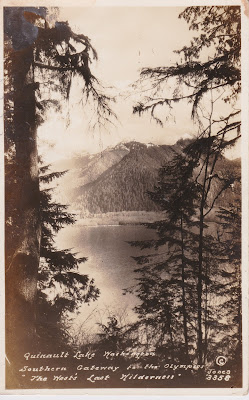Lunchroom cafeteria, Carlsbad Caverns, New Mexico, ca 1940s
The lunchroom in the Carlsbad Caverns National Park, New Mexico is featured on this unused Linen-Type postcard. It is labeled as a genuine Curt Teich, C.T. Colortone, postcard distributed by Herman Hemler of Carlsbad, New Mexico. As mentioned previously, Linen Type cards were popular during the 1930s through the beginning of the 1950s. The paper used had a higher rag count and produced a linen-like appearance that is also noticeable to the touch. The Colortone process produced rich colors. Curt Teich of Chicago postcards usually have an alpha-numeric code from which the year of issue can be determined. This card has the Helmer number of 114 and the C.T. number 9B-H1472 on the reverse in the box labeled for a stamp.
The lunchroom was built in the big cavern room, called Big Cave or The Hall of the Giants, in 1928, two years before the cave became a national park. Although food is no longer cooked in the cave, sandwiches, salads, desserts and other food not requiring cooking as well as soft drinks and hot drinks are still served. Originally visitors to the caves had to hike for approximately 6 hours to reach this large cavern; hence a place to sit and eat was very popular. As it turned out cooking food in the caverns was not a good idea as it began to drastically change the Eco-system and also attracted unwanted animals like raccoons, ringtail cats, and skunks. The park service has been trying to close it; however, the lunchroom is privately owned and operated. So far any attempts to close it down has met with opposition from local businessmen and politicians who want to keep it open.
In 1932 the national park added two elevators so that people would not have to walk down and back up the long switchback ramp to the big cavern located 750 feet or 230 meters below the surface. A museum, first aid area, and restrooms are also to be found in the large cavern that holds the lunchroom. It is possible to purchase and mail postcards cancelled with “Mailed from 750 feet below ground.”
Discovered by a boy named Jim White, who explored the cavern system descending by a homemade wire ladder, today the caverns are open year round with a constant temperature of 56 degrees F or 13 degrees C. White named many of the 23 areas within the cave system including the Big Cave also known as The Hall of the Giants. The Bat Cave is home to the majority of bats who inhabit the caves. Bat guano was mined there in the early 20th century. Unfortunately, the lights installed to aid tourists are not helpful to the native bats who will not go out to feed in the evening or come home to roost in the morning when the lights are on in the lunchroom. They need the darkness.
For more information, see:
https://www.collectorsweekly.com/postcards/linen
http://www.thepostcard.com/walt/curt.html
http://www.amusingplanet.com/2014/01/carlsbad-caverns-underground-lunchroom.html
https://en.wikipedia.org/wiki/Carlsbad_Caverns_National_Park






















































